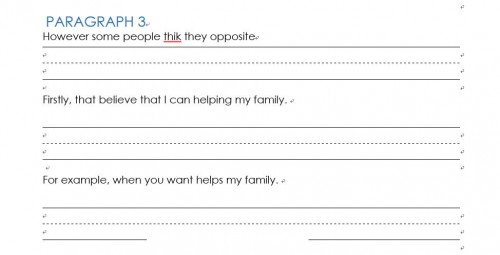Staying the Course in Level 2: The Opinion Essay
Gerry GibsonAs I write, the first full year of the new Foundations FIP (Foundations Intensive Program) is nearing completion. Students who in Cycle 1 matriculated into FIP from high school at Levels 2 or higher are, for the most part, on the cusp of successfully reaching the elusive IELTS Band 5. This type of success was typical of those students who matriculated into Level 2 under the previous Foundations program, but had the luxury of more time to reach that goal. At RKWC, those who matriculated into Level 2 quite regularly gained entry into the Bachelor’s program after a full year in Foundations which meant 16 weeks in Level 2, another 16 weeks in Level 3, and a final 16 weeks in Level 4 if necessary. Under the previous program, one of the motivational anecdotes that I relied upon was this:
“walking through the corridors and around campus I’m always running into old Level 2 students working hard towards their Bachelor’s degrees”.
I find that this message hits home in the Level 2 classroom, and as a teacher I use it over and over again in an effort to keep motivational levels high. I’m also finding this to be the case with the current group of FIP L2 students, some of whom have recently achieved Band 5. This should serve to motivate students and teachers both.
With the FIP in its first full year, we now find ourselves in uncharted territory in Level 2 as we begin FIP Cycle 5. These students are those that barely made it through Level 1 after perhaps two or three failed attempts along with students who have unfortunately failed Level 2 multiple times. Time is of the essence now with two cycles remaining to prepare these students for the IELTS exam. It is a daunting task, but with a vision towards ramping up to the IELTS task 2 opinion essay, it’s not a mountain that can’t be climbed.
 My particular focus has been on the opinion essay, and I have found that over the 6 weeks of intensive writing practice that the Level 2s of cycle 4 have made noticeable improvements. Here are some of the techniques we used in attempting to facilitate understanding of the rhetorical functions and chunking as per the Gary Pathare materials being used in Levels 3 and 4:
My particular focus has been on the opinion essay, and I have found that over the 6 weeks of intensive writing practice that the Level 2s of cycle 4 have made noticeable improvements. Here are some of the techniques we used in attempting to facilitate understanding of the rhetorical functions and chunking as per the Gary Pathare materials being used in Levels 3 and 4:
- Introduce the rhetorical functions of the opinion 3-7-7-3 opinion essay
- Use side-by-side 3-7-7-3 model opinion essays and have the students underline the chunks that need to be memorized in each. Students will notice that the chunks of language in both essays are the same.
- Introduce a new opinion essay topic each week with time allotted for individual feedback sessions.
- Provide two to three feedback sessions on each piece of writing; this is manageable at RKWC given the class sizes in Level 2 cycle 4 are between 10 and 12.
- Give bi-weekly progress tests to assess progress.
- Prepare worksheets with common errors taken from student essays. Use this as an in class activity where students attempt to identify mistakes and rewrite them, eventually on the whiteboard. The focus here would not only be on mistakes made in chunking, but also in the clauses and noun phrases used beyond the chunks.

These are sample problem sentences in the Level 2 student opinion essay.
The following are the problems that crop up in most of the Level 2 essays:
 Confusing and mixing rhetorical functions and chunking taught previously with those taught in the FIP materials.
Confusing and mixing rhetorical functions and chunking taught previously with those taught in the FIP materials.- Misunderstanding of how the two opinions in paragraphs 2 and 3 should be presented. For example, look at the following topic: “Many people think it’s a good idea to eat fast food. Other people think it’s a good idea to cook at home . What do you think?”
- The student states her opinion in the introduction, but presents the other side as her opinion in paragraph two.
- The student misunderstands the question and gives an opinion of something unrelated or only partly related to the question, such as writing about eating healthy food as opposed to cooking at home.
- Misunderstanding of how to plan and arrange the 3 reasons and 3 examples in paragraphs 2 and 3.
- The first reason is worded the same way as their opinion statement.
- The reason and example do not complement each other.
- The student fails to provide an example.
- The student uses the same reason and/or example twice in the same paragraph.
- The example is basically a paraphrased version of the reason.
- Misunderstandings of how the conclusion should be written.
- I personally feel that statement does not match their stated opinion in the introduction.
- If conditional does not match their stated opinion.
- If conditional is incomplete.
I have also identified a number of common grammatical problems that frequently present themselves in the opinion essay:
- Many people nowadays prefer think; doubling up on the verb.
- My first reason is that/Firstly followed by a verb phrase not a complete sentence.
- This means that/For example followed by a verb phrase not a complete sentence.
- If conditional consists of only the first clause.
The issues above by no means capture all of the Level 2 opinion essay issues. They do seem to represent the some of the common issues that get in the way of most students being able to produce a comprehensible opinion essay. Most RKWC Level 2 students have a level of grammar, spelling, and intelligibility that is functional. I have stayed the course from week 1 through to week 5 via a vigilant approach to pushing the fundamentals of this essay as laid out above, and I’ve seen plenty of progress with most students by week 5. That is not to say that this progress is enough to overcome the fundamental grammatical and vocabulary weaknesses that many of these students suffer from. However, the ability to grasp the 3 7 7 3 approach as laid out in the Level 3 and 4 materials and pitched at a more accessible level in Level 2 might be enough to get them to Level 3 and hopefully beyond. If not, there’s no harm in trying.

